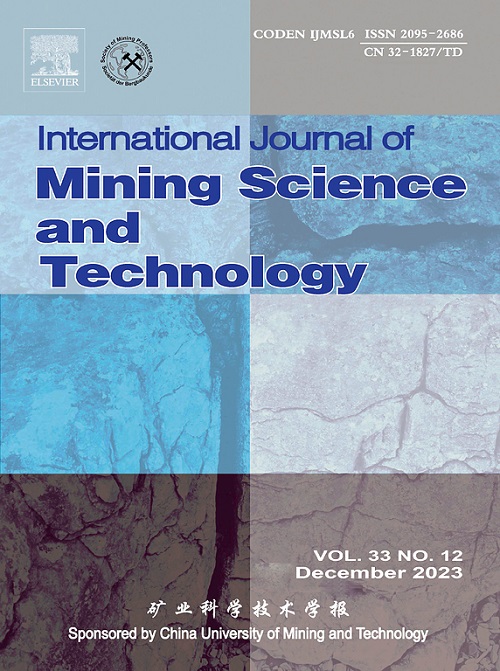单斜黄铁矿(0 0 1)和方铅矿(1 0 0)表面电化作用的电化学和 DFT 研究
IF 11.7
1区 工程技术
Q1 MINING & MINERAL PROCESSING
International Journal of Mining Science and Technology
Pub Date : 2024-08-01
DOI:10.1016/j.ijmst.2024.07.010
引用次数: 0
摘要
研究了方铅矿和单斜黄铁矿之间的电化学相互作用,以考察其对矿物微表面物理和化学特性的影响。这项研究采用了电化学、金属离子剥离、X 射线光电子能谱和量子化学等技术。电化学测试结果表明,与单斜黄铁矿表面相比,电偶系统中的方铅矿表面具有更低的静电电位和更高的电化学活性,因此更容易被氧化溶解。单斜黄铁矿大大提高了方铅矿表面的腐蚀速率。Mulliken 电荷群计算表明,电子始终从方铅矿转移到单斜黄铁矿,随着相互作用距离的减小,矿物表面的电子转移数量也在增加。状态密度分析表明,方铅矿的表面状态密度向低能级转移,导致反应活性降低,试剂吸附到矿物表面的难度增加。相反,单斜黄铁矿则表现出相反的趋势。X 射线光电子能谱(XPS)测试结果表明,电化作用导致方铅矿表面形成亲水性物质 PbSxOy 和 Pb(OH)2。此外,单斜黄铁矿表面不仅能吸附 Pb2+,还能形成 S0,从而增强了其疏水性。本文章由计算机程序翻译,如有差异,请以英文原文为准。
Electrochemistry and DFT study of galvanic interaction on the surface of monoclinic pyrrhotite (0 0 1) and galena (1 0 0)
The electrochemical interaction between galena and monoclinic pyrrhotite was investigated to examine its impact on the physical and chemical properties of the mineral micro-surface. This investigation employed techniques such as electrochemistry, metal ion stripping, X-ray photoelectron spectroscopy, and quantum chemistry. The electrochemical test results demonstrate that the galena surface in the electro-couple system exhibits a lower electrostatic potential and higher electrochemical activity compared to the monoclinic pyrrhotite surface, rendering it more susceptible to oxidation dissolution. Monoclinic pyrrhotite significantly amplifies the corrosion rate of the galena surface. Mulliken charge population calculations indicate that electrons are consistently transferred from galena to monoclinic pyrrhotite, with the number of electron transfers on the mineral surface increasing as the interaction distance decreases. The analysis of state density revealed a shift in the surface state density of galena towards lower energy levels, resulting in decreased reactivity and increased difficulty for the reagent to adsorb onto the mineral surface. Conversely, monoclinic pyrrhotite exhibited an opposite trend. The X-ray photoelectron spectroscopy (XPS) test results indicate that galvanic interaction leads to the formation of hydrophilic substances, PbSxOy and Pb(OH)2, on the surface of galena. Additionally, the surface of monoclinic pyrrhotite not only adsorbs Pb2+ but also undergoes S0 formation, thereby augmenting its hydrophobic nature.
求助全文
通过发布文献求助,成功后即可免费获取论文全文。
去求助
来源期刊

International Journal of Mining Science and Technology
Earth and Planetary Sciences-Geotechnical Engineering and Engineering Geology
CiteScore
19.10
自引率
11.90%
发文量
2541
审稿时长
44 days
期刊介绍:
The International Journal of Mining Science and Technology, founded in 1990 as the Journal of China University of Mining and Technology, is a monthly English-language journal. It publishes original research papers and high-quality reviews that explore the latest advancements in theories, methodologies, and applications within the realm of mining sciences and technologies. The journal serves as an international exchange forum for readers and authors worldwide involved in mining sciences and technologies. All papers undergo a peer-review process and meticulous editing by specialists and authorities, with the entire submission-to-publication process conducted electronically.
 求助内容:
求助内容: 应助结果提醒方式:
应助结果提醒方式:


